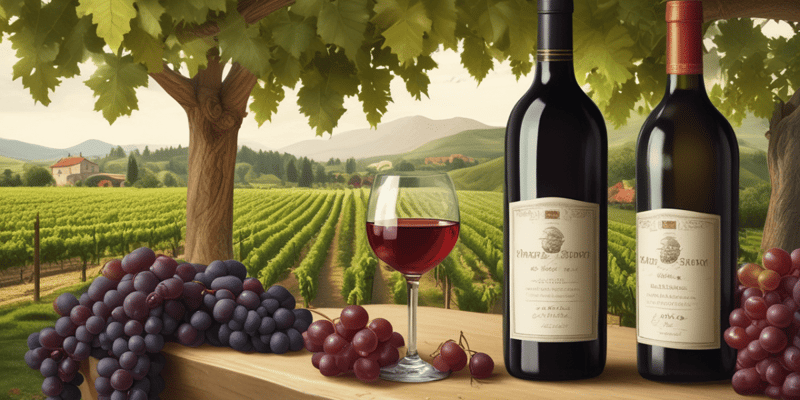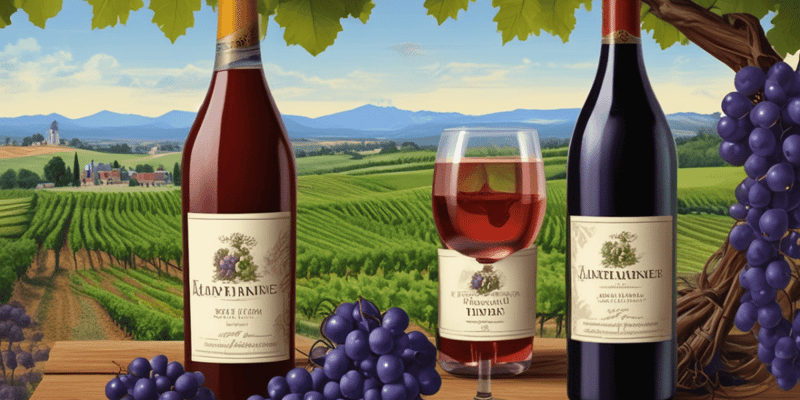Questions and Answers
What is the science of wine and winemaking called?
Oenology
What are the two main categories of wine production?
Still and sparkling
What are the five stages of the winemaking process?
Harvesting, primary fermentation, malo-lactic conversion, maturation, and clarification
What is the process of breaking the skins to start to liberate the contents of the berries called?
Signup and view all the answers
What is the most common preservative used in winemaking?
Signup and view all the answers
What is the process used to reduce tartrate crystals in wine by dropping the temperature of the wine close to freezing for 1-2 weeks called?
Signup and view all the answers
What is the name of the common fining agent used in winemaking to remove impurities?
Signup and view all the answers
What is the process used to achieve the desired taste and remove tannins, astringency, and microscopic particles that could cloud the wine called?
Signup and view all the answers
What is the name of the process used to separate juice or wine from grapes and grape skins by applying pressure to grapes or pomace?
Signup and view all the answers
Study Notes
Production of Wine
-
Winemaking is the process of producing wine, starting with fruit selection, fermentation, and bottling.
-
The science of wine and winemaking is called oenology, and a winemaker may also be called a vintner.
-
There are two main categories of wine production: still wine (without carbonation) and sparkling wine (with carbonation).
-
Red, white, and rosé are the main categories of wine, but wine can also be made from other plants.
-
The process of winemaking involves five stages: harvesting, primary fermentation, malo-lactic conversion, maturation, and clarification.
-
The quality of the grapes determines the quality of the wine, and grape quality is affected by variety, weather, soil minerals, acidity, time of harvest, and pruning method.
-
Grapes are usually harvested from September to November in the northern hemisphere, and February to March in the southern hemisphere.
-
Mechanical harvesting is used to cover a large area of vineyard land in a short time, while manual harvesting has the advantage of using knowledgeable labor to pick only ripe clusters.
-
Crushing is the process of breaking the skins to start to liberate the contents of the berries, and destemming is the process of removing the grapes from the rachis.
-
Yeast is normally already present on the grapes, and cultured yeast is often added to the must to ensure predictable results.
-
During the primary fermentation, yeast cells feed on the sugars in the must and multiply, producing carbon dioxide gas and alcohol.
-
The temperature during the fermentation affects both the taste of the end product, as well as the speed of the fermentation.Winemaking Process: Pressing, Pigeage, Malolactic Fermentation, Laboratory Tests, Blending and Fining
-
The sugar percentage of the grape must should be around 24% for winemaking.
-
Sugar content can be increased by adding sugar (chaptalization) if the grapes do not have enough sugar.
-
Yeasts that can tolerate high alcohol levels can be used to make wines with more than 12% alcohol.
-
Pressing is the act of applying pressure to grapes or pomace to separate juice or wine from grapes and grape skins.
-
Pressing is not always necessary, as free-run juice can be used for vinification.
-
Pressed juice is of lower quality than free-run juice due to increased phenolic compounds, browning index, and C6-alcohol levels.
-
Modern presses dictate the duration and pressure at each press cycle, with the use of press cuts to separate the streams of pressed juice.
-
Pigeage is the management of acidity and secondary pressing of grapes in fermentation tanks.
-
Cold stabilization is a process used to reduce tartrate crystals in wine by dropping the temperature of the wine close to freezing for 1-2 weeks.
-
Malolactic fermentation occurs when lactic acid bacteria metabolize malic acid to produce lactic acid and carbon dioxide.
-
Laboratory tests are conducted periodically to check the status of the wine, including tests for Brix, pH, titratable acidity, residual sugar, free or available sulfur, total sulfur, volatile acidity, and percent alcohol.
-
Blending and fining are used to achieve the desired taste and remove tannins, astringency, and microscopic particles that could cloud the wine.Winemaking Processes: Fining, Preservatives, Filtration, Bottling, and Regulation
-
Gelatin is a common fining agent used in winemaking to remove impurities.
-
Other animal-based fining agents include egg whites, bone char, and isinglass.
-
Non-animal-based filtering agents include bentonite, diatomaceous earth, and cellulose pads.
-
The most common preservative used in winemaking is sulfur dioxide, which has anti-microbial and anti-oxidant properties.
-
Potassium sorbate is another preservative used for fungal control, but it can produce an unpleasant by-product.
-
Natural winemaking involves no preservatives, and the wine is refrigerated after bottling to prevent spoilage.
-
Filtration is used for clarification and microbial stabilization, with different levels of filtration required for each.
-
Bottling involves adding a final dose of sulfite to preserve the wine and prevent unwanted fermentation, followed by sealing with a cork or alternative closure.
-
Winemakers are traditionally known as vintners and can be employed by wineries or work independently.
-
The EU requires member states to appoint competent national authorities to ensure compliance with EU rules in the wine sector.
-
The top 15 wine-producing countries by volume include Italy, Spain, France, and the United States.
-
Winemaking involves a complex set of processes that can vary greatly depending on the desired outcome and the winemaker's preferences.
Studying That Suits You
Use AI to generate personalized quizzes and flashcards to suit your learning preferences.
Description
Think you know everything about the production of wine? Test your knowledge with our quiz on winemaking! From the different categories of wine to the stages of winemaking and the use of preservatives and filtration, this quiz covers it all. Learn about the importance of grape quality, the role of yeast in fermentation, and the various fining agents used to clarify wine. Whether you're a wine enthusiast or simply curious about the process, this quiz is sure to challenge and enlighten you. So




